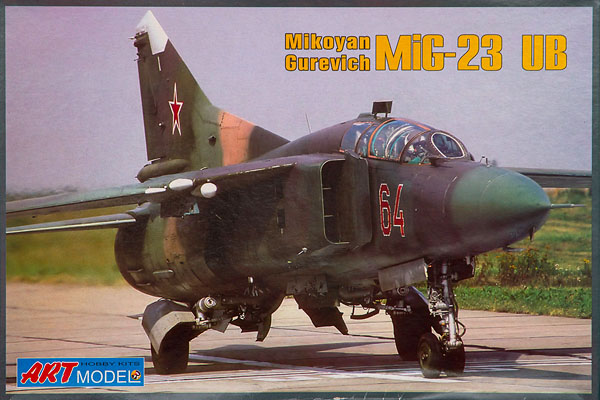
Art Model 1/72 MiG-23UB
By Chris Banyai-Riepl
Overview
The Mikoyan Gurevich MiG-23 was the Soviet Union's first attempt at developing a look-down/shoot-down fighter aircraft with beyond visual range weaponry. Production began in 1970 and over 5,000 MiG-23s were built. Training future pilots in this complex aircraft required a dedicated trainer, and the MiG-23U was developed from the first generation MiG-23S. To help bridge the gap in performance between the trainer and the newer second generation MiG-23s, the MiG-23UB was created, replacing the older R-27 engine with themore powerful R-29. Over 700 MiG-23UB aircraft were produced before production ceased in 1985.
The Kit
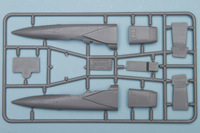 To the best of my knowledge, this is the only injection molded 1/72 kit of the two-seater MiG-23UB out there. Molded in a medium gray plastic, the kit features some very petite recessed panel lines and riveting, but some of the other details are a bit soft. The cockpits are resin, as is the exhaust, and the comprehensive decal sheet provides markings for sixteen options from fourteen different countries.
To the best of my knowledge, this is the only injection molded 1/72 kit of the two-seater MiG-23UB out there. Molded in a medium gray plastic, the kit features some very petite recessed panel lines and riveting, but some of the other details are a bit soft. The cockpits are resin, as is the exhaust, and the comprehensive decal sheet provides markings for sixteen options from fourteen different countries.
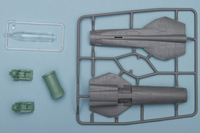 Construction begins with the cockpit, and here we can see that this kit is engineered to get the maximum number of variants out of a single series of molds. The nose is separate, and the resin cockpit tubs get sandwiched between the two halves. The resin cockpits have the seat molded in place, so the only thing left to attach is the instrument panels and control columns. As the canopy is only provided in the closed format, the level of detailing present here is more than adequate.
Construction begins with the cockpit, and here we can see that this kit is engineered to get the maximum number of variants out of a single series of molds. The nose is separate, and the resin cockpit tubs get sandwiched between the two halves. The resin cockpits have the seat molded in place, so the only thing left to attach is the instrument panels and control columns. As the canopy is only provided in the closed format, the level of detailing present here is more than adequate.
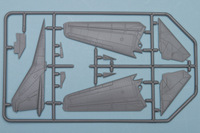 With the nose section finished (and do note, you will need some weight up front to keep this on all three legs), the rear fuselage assembly is next. This is split into upper and lower pieces, done so in order to trap the wings in between. The wings can be positioned at any angle, but on the ground they're either fully extended or fully swept. If you sweep the wings fully back, you will likely need more weight in the nose, so be aware of that. Once the rear fuselage is together, you can mate up the front piece and move onto the smaller details.
With the nose section finished (and do note, you will need some weight up front to keep this on all three legs), the rear fuselage assembly is next. This is split into upper and lower pieces, done so in order to trap the wings in between. The wings can be positioned at any angle, but on the ground they're either fully extended or fully swept. If you sweep the wings fully back, you will likely need more weight in the nose, so be aware of that. Once the rear fuselage is together, you can mate up the front piece and move onto the smaller details.
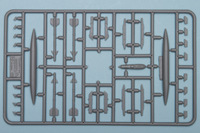 The air intakes are separate and feature separate splitter plates. The vertical fin and stabilizers are also separate, as are the rear fuselage air brakes. I have seen some MiG-23s on the ground with these brakes open, so if you so wish, it offers another bit of visual interest. The exhaust is resin, and features a nice deep pipe with great burner can detailing. The ventral fin is made up from three pieces, which might be a bit challenging to get lined up right. Some care in test fitting here should alleviate that issue, though.
The air intakes are separate and feature separate splitter plates. The vertical fin and stabilizers are also separate, as are the rear fuselage air brakes. I have seen some MiG-23s on the ground with these brakes open, so if you so wish, it offers another bit of visual interest. The exhaust is resin, and features a nice deep pipe with great burner can detailing. The ventral fin is made up from three pieces, which might be a bit challenging to get lined up right. Some care in test fitting here should alleviate that issue, though.
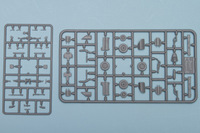 For the landing gear, these are quite sturdy, as are the originals. The detailing on these parts is a bit soft, but as much of the main gear struts are covered by the wheels and gear doors, not much of that softness will be seen. The kit comes with some air to air missiles, as well as a centerline drop tank. The only photos of the MiG-23UB I've turned up shows it carrying fuel tanks, not weaponry, but the option is there in the kit.
For the landing gear, these are quite sturdy, as are the originals. The detailing on these parts is a bit soft, but as much of the main gear struts are covered by the wheels and gear doors, not much of that softness will be seen. The kit comes with some air to air missiles, as well as a centerline drop tank. The only photos of the MiG-23UB I've turned up shows it carrying fuel tanks, not weaponry, but the option is there in the kit.
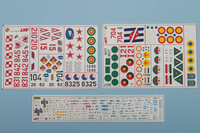 The real treat in this kit is the marking options. As noted, there are sixteen options, with two from Poland and two from Russia. The rest are single options from Cuba, Czech Republic, Libya, Iraq, East Germany, Algeria, Romania, India, Angola, Hungary, Ethiopia, and Ukraine. Camouflage colors are all over the place, with most featuring broad color patterns in two or three color schemes. One of the Polish options is overall gray, while the Romanian one features small light tan spots on a darker brown base. The decals look to be well printed with a matte finish.
The real treat in this kit is the marking options. As noted, there are sixteen options, with two from Poland and two from Russia. The rest are single options from Cuba, Czech Republic, Libya, Iraq, East Germany, Algeria, Romania, India, Angola, Hungary, Ethiopia, and Ukraine. Camouflage colors are all over the place, with most featuring broad color patterns in two or three color schemes. One of the Polish options is overall gray, while the Romanian one features small light tan spots on a darker brown base. The decals look to be well printed with a matte finish.
Conclusion
While not up to the same level as the latest Hasegawa or Eduard kit, this remains the only real choice to build a two-seater MiG-23 in 1/72 scale. With a bit of effort it will undoubtedly turn into a great representation of this iconic swing-wing Russian aircraft. My thanks to Armory for the review sample.
